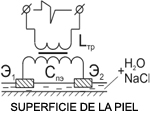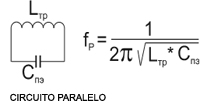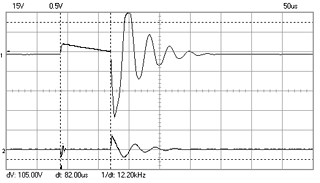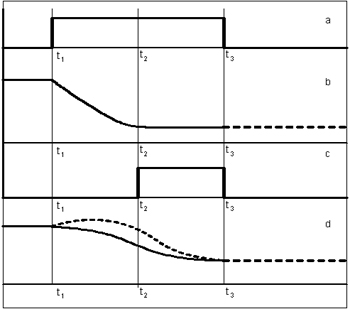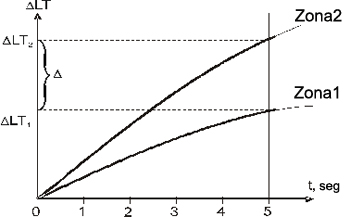BIOPHYSICAL BAISIS OF DYNAMIC ELECTRONEUROSTIMULATION METHOD
Gurov A.A., Koroleva M.V., Chernysh I.M., Meizerov E.E., Cheremhin K.Yu., Ivanov V.V.
Dynamic electroneurostimulation method (DENS) is a further evolution of transcutaneous electroneurostimulation (TENS) [10]. Principle consisting of monitoring of skin impedance during stimulation process underlies DENS. Monitoring is intended for observation and evaluation of reactions of vegetative nervous system according to modification dynamics of capacitive component indexes change of impedance of subelectrode area of the skin, which allows to optimize therapeutic algorithms [3, 4, 6, 7, 8, 11].
Evaluation of dynamics change of surface impedance during stimulation process was used before by creators of apparatus for the action dosage estimation; attempts to create a device with “biological feedback” were made. However, in all those cases there was no physiological basing of sufficiency criteria of stimulation dosage [2, 9].
It is well known that electrode of apparatuses that are used for DENS represents a condenser with self-capacitive value about C0 = 0.1 nF, and when it touches skin surface it causes an increase of this capacity with a gradual plateau rise up to the value of ones and tens of nanofarad during few minutes [2]. Most likely that the cause of this effect is an appearance of natural hydrophilic padding in the form of aqueous solution of sodium chloride and other substances with high permittivity. In the model for the plain capacitor the value of capacitive component of impedance is determined according to the following formula:
Cpe
where εо - permittivity of free space; ε - permittivity of hydrophilic padding (for example, for water ε=80, for sodium chloride ε=6), S – square of electrodes, d – distance between electrodes. At the same time, it is necessary to say that ε parameter depends on temperature, pressure and concentration, ε0 depends on system of units selection, and capacity value depends on geometric correlation of electrodes, but it does not depend on the conductor material [12]. Stimulation application causes more drastic change of capacity value at the time of plateau rise [2]. It is necessary to say that stability of impedance value on the plateau was relative, because a slow drift of capacity value towards its increase was observed.
On the picture 1 an equivalent scheme of output stage of DENS apparatus is represented (scheme 1a); it consists of built-in electrodes E1 and E2 which are connected to the secondary winding of output transformer on the primary winding of which stimulation impulses are sent. This equivalent scheme represents a parallel circuit (scheme 1b), which is formed by inductance of output transformer Ltr and Cpe - total self-capacity between E1, E2 electrodes and capacitive component of impedance of subelectrode area of the skin – between E1, E2 electrodes with hydrophilic padding on the skin surface.
1a
1b 1c
Picture 1. Equivalent scheme of output stage of DENS apparatus, explanations are given in the text.
The main parameter for evaluation of dynamics of electrocutaneous characteristics in the stimulation process is the resonance frequency value of parallel oscillatory circuit (formula 1c) where current resonance happens [5].
As is well known, pulse shape for DENS always consists of two phases [3, 4, 7, 8]. The first phase that is regulated in duration is meant for control of launch power of stimulator. And the second phase is forced relaxation sinusoidal vibrations which have 2 functions: direct stimulation and at the same time they are a source of information for evaluation of stimulation process nature. These vibrations are the result of impact excitation of circuit from the first impulse phase [3] that is formed by control unit of electrostimulator. Processes that take place in such circuit are described in literature in full [5]. These vibrations are formed directly on the electrodes of the apparatus. An active impedance component of subcutaneous area of the skin has an impact on the resonance Q-factor and accordingly on the rate of damping of forced oscillations. Its value strongly depends on the pressure force of electrodes on the skin surface, is not stable and, therefore, does not have a diagnostic meaning.
Oscillograms of output pulse in DENS apparatuses without contact with skin surface are represented on Picture 2. Figure 1 indicates voltage oscillogram, figure 2 indicates oscillogram of current through the electrodes.
Picture 2. Oscillograms of output pulse in DENS apparatuses without the load, explanations are given in the text.
Oscillogram 1 represents an output voltage signal. The first phase is clearly notable; the second phase is forced relaxation vibrations at frequency about 30 kHz. Calculation of resonance frequency of the circuit at L=150 mH и С0=0,15 nF gives the same value, about 30 kHz.
Descent rate of oscillation frequency in a circuit depends on the appearance and rate of change of aqueous solution of hydrophilic padding in the subelectrode zone which also depends on the activation level of vegetative nervous system. The solution concentration changes in the process of stimulation and so the frequency at the second stage changes accordingly up to 2 kHz and less.
Thus, monitoring of impedance of subelectrode area of the skin surface that is accomplished through certain frequencies and evaluations of its change dynamics underlies two basic DENS functions: minimal effective dosage program (MED) and method of discovering and localization of latent trigger reflexogenic zones – screening-research (SCREENING).
Minimal effective action dosage
Well-founded determination of action dosage on reflexogenic zones undoubtedly is an important problem, especially considering wide application of DENS apparatuses at home. However, as it was showed in the previous researches [2, 9], principle of determination of action sufficiency that underlies dosed mode of operation, is not physiologically grounded for number of apparatuses.
All that was a reason for determining certain parameters. On the basis of their analysis formation of algorithm of effective minimal action dosage that would be sufficient for steady change of psychophysiological state of the body becomes possible. According to research results [9], an action program was created at frequency 10 Hz, and it got a name MED.
Temporal diagrams of signals are represented on Picture 3: temporal stimulation interval is represented on the diagram “a”; pattern of change of capacitive component of impedance of subelectrode area of the skin is represented on the diagram “b”; temporal stimulation interval after impedance value stabilization is represented on the diagram “c”; standard graph of voltage index change (VI) is represented on the diagram “d”.
Picture 3. Temporal signal diagrams of MED program, explanations are in the text.
Before the stimulation started background indexes of vegetative homeostasis differed for different persons. The most high values of VI showed people with cardiovascular pathology in anamnesis as well as patients with sensations of pain at the time of research. During 5 minutes of background registration VI stabilized, its change curve rose to the plateau (picture 3, diagram “d” to t1). After the stimulation was activated (diagram “a” at the t1 moment) in the main test series the majority of studied patients at first showed increase of voltage index (diagram “d” at the t1 moment) up to 10-35% and change of other indexes of vegetative regulation towards sympathetic activation prevalence and increase of voltage of vegetative regulation. After the stimulation started 5 healthy volunteers (at the t1 moment), on the contrary, showed slow reduction of voltage index and decrease of sympathetic activation. After the stimulation, during first 1-1.5 minute gradual reduction of voltage index took place (diagram “d” from t1 to t2) as well as change of other indexes of vegetative regulation towards decrease of voltage (lowering of mode amplitude, range increase, displacement of vegetative rhythm index towards parasympathetic activation, etc.). It is necessary to say that such tendency of change of indexes of vegetative regulation also was observed at the time of stimulation of neck-color zone and peripheral zones on extremities.
Change of electrical quantities of the skin occurred parallel to the dynamics of physiologic indexes. After stimulation started an increase of capacity value in the subelectrode zone was observed and, therefore, a reduction of impedance value (diagram “b” from t1 tо t2) up to its stabilization was noticed.
Starting from stabilization moment of capacitive component (at the t2 moment), stabilization of state as well as plateau rise of a curve of voltage index change always occurred during 1-2 stimulation minutes (diagram “d” before the t3 moment).
Parallel to the vegetative regulation indexes change of electroconductivity of skin and at that particular time diapason certain changes of subjective sensations of studied people were registered also. Patients with pain syndromes noticed reduction of pain intensity exactly at that time; healthy volunteers noticed a subjective reduction of stimulation amplitude. Thus, dynamics correlation of capacitive component of impedance of subelectrode area of the skin with the vegetative regulation indexes and subjective sensations of studied people is an evidence of the fact that this particular index could be used for an estimation of minimal though effective enough action dosage.
Screening-checkup
Internal organs’ dysfunctions result in appearance of modified sensitivity zones in the certain limited skin areas. These zones are extrinsic to a healthy body and could not be revealed on the rest symmetrically located body areas. These zones are called latent trigger reflexogenous zones. In contrast to active reflexogenous zones which could be detected by a doctor at a time of questioning or examination of patients, latent zones could be detected and localized with a help of diagnostic methods. Methods of measurement of electrocutaneous conductivity either in the frontal projection zones of the target affected organ or in the remote skin areas of segmental and off-segmental innervation are included in that group of methods which is determined by viscerocutaneous or visceromotor communications.
According to the research [3], the most informative parameter for the method of revealing and localization of latent trigger reflexogenous zones is not forced oscillation value and not so much speed of their change value, but speed difference module in the neighboring areas of a skin surface.
Picture 4 represents graphics that describe speed difference determination ∆ of frequency change (or impedance) for two zones of skin surface that is represented in standard units ∆LT (latent triggers delta). It is seen that Zone1 shows the speed ∆LT1, and Zone2 has ∆LT2 speed. As it was said previously, the most diagnostic meaning has the difference of these two speeds without ∆ ═│ ∆LT1- ∆LT2 │sign; it has dimension [Hz/sec] relative to the frequency and [nF/sec] relative to the capacitive value of impedance. To make this method easier for the users developers decided to transform ∆LT parameter to the standard units in the diapason from 0 to 100. The maximum value “100” corresponds to the 18 nF capacity value. 5 seconds calculation interval was chosen considering that such interval is small enough for an effective stimulation.
Picture 4. Determination of ∆LT for two zones, explanations are given in the text.
This method of revealing and localization of latent trigger zones was called screening-research and realized in the apparatuses “DiaDENS” series. A large body of data that was received as a result of application of these apparatuses in medical practice reveals how informative such kind of examinations is for skin surface checkup.
As a result of the research [3] the following fact was determined: absolute values of DLT index that shows the rate of rise of capacitive component of impedance during 5 seconds of the testing are not informative enough for the pathologic skin areas revelation. The researchers failed to find quite narrow universal “norm corridor” for all the examined people by analogy with electropunctural functional diagnostics method by R. Fall. The ∆LT values differed for different examined people and in different anatomical areas for the same person. The same ∆LT values could be applicable for “healthy” segments in some patients and for “pathological” segments in others. A perspiration level is determined by activation level of vegetative nervous system both of segmental and over-segmental levels. Activity level of sympathetic region of vegetative nervous system, in its turn, significantly spreads in values depending on sex, age, temperament type, psychoemotional state, level of sex and other hormones , etc. [1].At the same time difference module of speed change of impedance both on the right and on the left in symmetrical zones proved to be informative enough. It was determined that ∆ ≥5 values correspond with pathology of organs that are innervated by sympathetic or somatic part of particular segment. It is necessary to mention that in the presence of an inflammatory disease higher ∆LT values were observed on the affected side while in the presence of degenerative disorders without an exacerbation they were observed on the healthy side.
The other informative parameters of screening-research were determined as well. It was noticed that values in diapason from ∆LT > 90 to ∆LT=100 were observed in the presence of arthritis and arthrosis of joints in the acute period which were followed by pain syndrome. At the same time there were no parameters’ asymmetry on the affected and healthy sides. That is caused by very low initial impedance value, and that is why ∆LT increase occurred rapidly and outside of the scale. Thus, exceeding of absolute values ∆LT > 90 could be considered as a significant diagnostic criteria of the method.
In some cases change of ∆LT absolute values in comparison with neighboring areas was observed in the presence of internal organs’ pathology in the corresponding dermatome. Also, ∆> 5 value asymmetry on the right and on the left was observed in the presence of acute condition or exacerbation of chronic condition. It could be assumed that increase of this value will be seen in the presence of inflammatory process and decrease of the value in the presence of degenerative process. However, data of more precise instrumental pathology diagnostics that were represented only by patients with vertebrogenous pathology is needed for confirmation of the previous assumption.
Zones of the first collateral back line and signal zones proved to be the most informative for the screening-research. This information corresponds with literature data of the most pronounced segmental action of acupuncture points which are located exactly at the first collateral back line as well as data of signal zones usage as diagnostically meaningful.
It was determined that absolute values of ∆LT <10 index have certain diagnostic meaning – they could point out the progressing degenerative changes in the corresponding vertebromotor segments which in the most cases are followed by the disk herniations.
Thus, following the research the optimal parameters of measurement were determined along with the diagnostic pathology criteria; the reliable correlation of screening-research indexes with clinical data was established in the group of patients with vertebrogenous pathology as well.
It is possible to add in a conclusion that dynamic electroneurostimulation is an effective addition to the standard methods which are used in treatment diseases followed by pain, functional disorders and inflammation. Taking into account possibility of independent treatment and good endurance of procedures DENS could be recommended for a long-term application in complex treatment.
Sourses
- Alderson A.A. Mechanisms of Electrodermal Reactions. Riga: Zinante, 1985.
- Gurov A.A., Budnikov Yu.F., Koroleva M.V., Meizerov E.E. Experimental Research of Characteristics of Surface Impedance During Transcutaneous Electrostimulation. // Electrostimulation – 2002. Proceedings of Scientific-Practical Conference on 27-28 of March 2002. M. – Publishing house “ARSRIMP-VITA” SRI of medical industry. pp . 118-123.
- Gurov A.A., Koroleva M.V., Chernysh I.M., and others. Research of Screening-Examination Parameters at the Time of “DiaDENS” Apparatus Application // Reflex Therapy. – 2005. # 3 (14). – pp. 28-34.
- Gurov A.A., Koroleva M.V., Chernysh I.M., and others. Main Principles of Screening-Research At the Time of “DiaDENS” Apparatus Application // Reflex Therapy. 2006. - # 2 (10). - pp. 27-31.


 Fisioterapia
Fisioterapia

